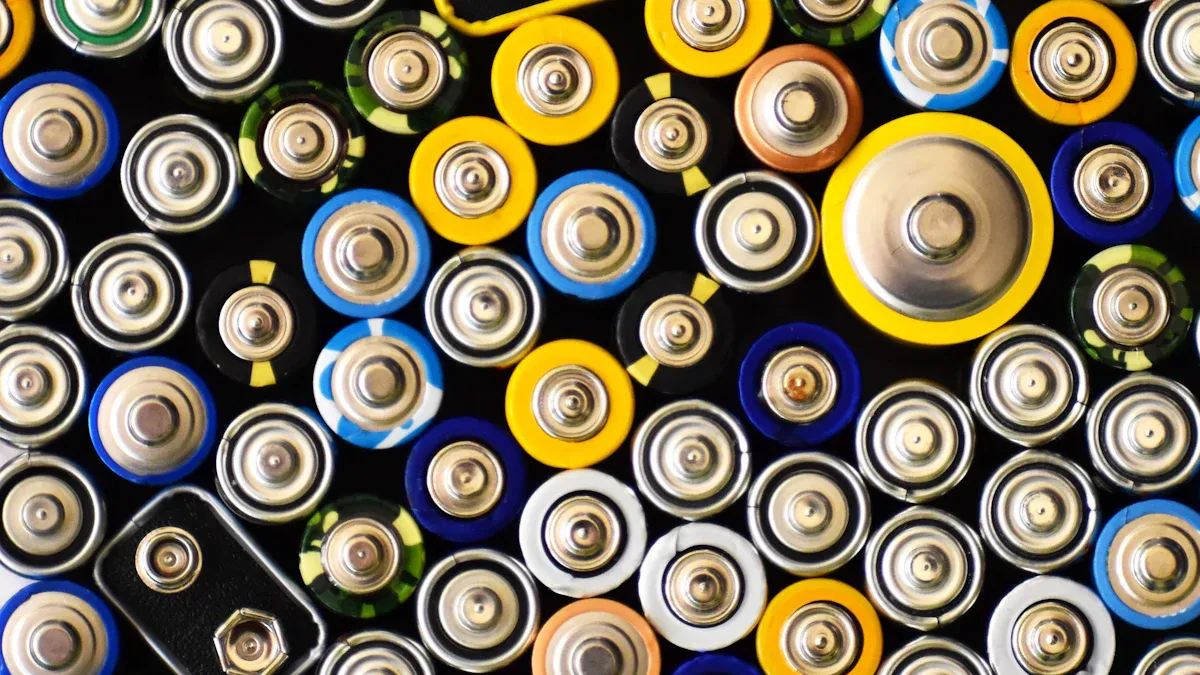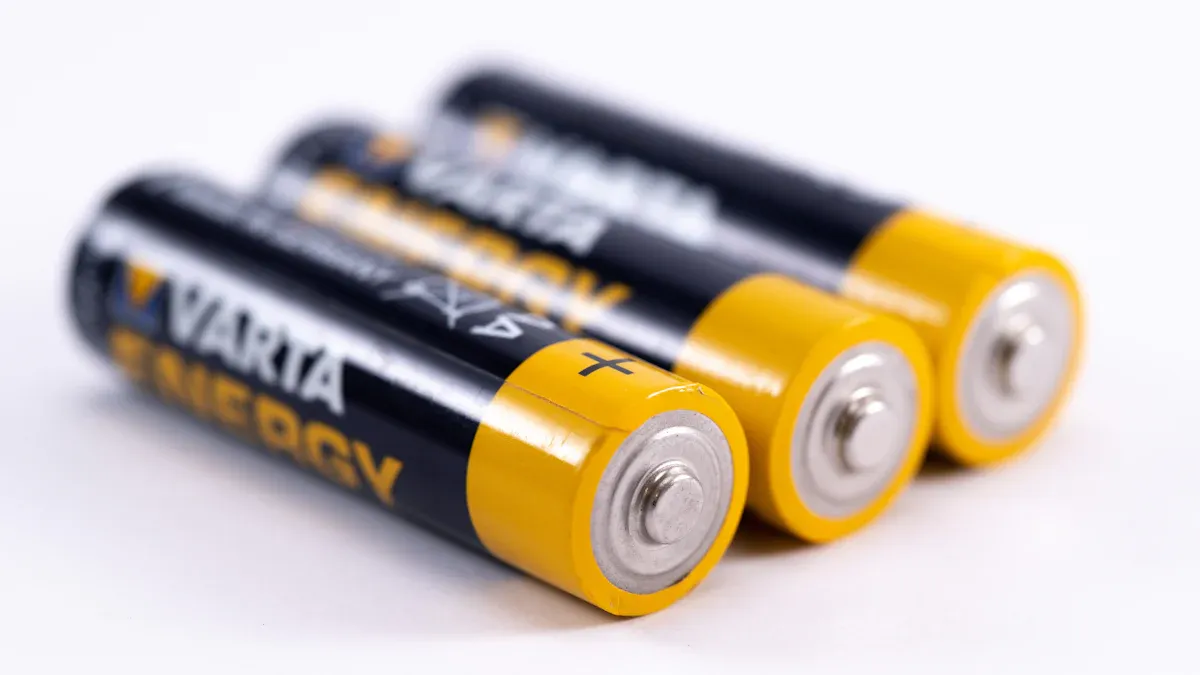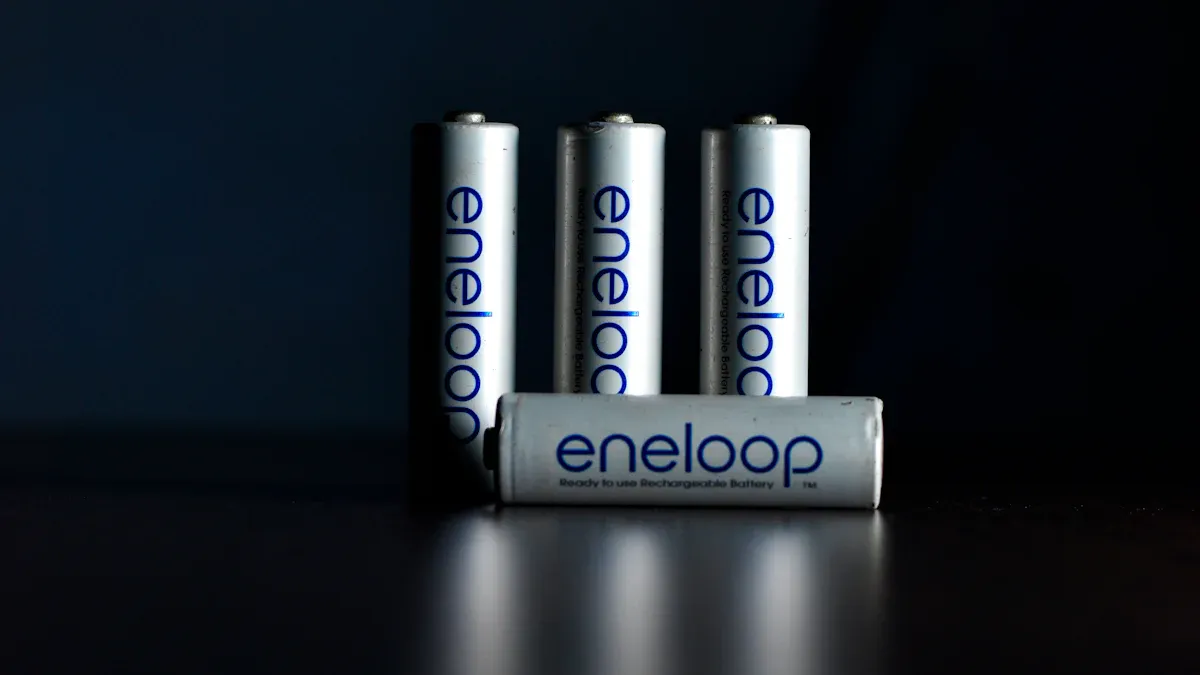
The alkaline battery market shows promising growth, projected to reach USD 10.18 billion by 2032, up from USD 7.69 billion in 2024. Key factors driving this expansion include rising demand for AA and AAA batteries, a shift toward eco-friendly products, and the increasing reach of e-commerce. Understanding these dynamics will help stakeholders seize future opportunities.
Key Takeaways
- The alkaline battery market is expected to grow from USD 7.69 billion in 2024 to USD 10.18 billion by 2032, driven by demand for AA and AAA batteries and eco-friendly products.
- Asia, particularly China, leads the market growth due to rising consumer electronics demand, while North America and Europe maintain substantial shares with slower growth.
- Key players like Duracell and Energizer focus on innovation and sustainability, enhancing their competitive edge in the evolving alkaline battery landscape.
Alkaline Battery Market Segmentation

Understanding the segmentation of the alkaline battery market is crucial for identifying growth opportunities. I find it fascinating how different applications drive demand in this sector.
By Application
The alkaline battery market can be segmented into several key application categories. Here’s a breakdown:
| Application Category | Description |
|---|---|
| Consumer Electronics | Holds the largest market share |
| Household Devices | Significant application category |
| Toys & Games | Important segment in the market |
| Industrial & Commercial | Notable application area |
| Others | Additional applications not specified |
I see consumer electronics leading the charge, with household devices and toys also playing significant roles. The industrial sector is noteworthy as well, showcasing the versatility of alkaline batteries.
By Region
Regional dynamics also shape the market landscape. Here’s how the market shares and growth rates differ across regions:
| Region | Market Share | Growth Rate | Key Drivers |
|---|---|---|---|
| Asia (China) | Largest | Fastest growing | Rising demand for consumer electronics |
| North America | Substantial | Slower growth | Established brands, higher per capita consumption |
| Europe | Substantial | Slower growth | Established brands, higher per capita consumption |
| Africa | Emerging | Considerable growth | Urbanization, rising demand for portable electronics |
| Latin America | Emerging | Considerable growth | Urbanization, rising demand for portable electronics |
I notice that Asia, particularly China, is rapidly expanding due to its growing consumer electronics market. Meanwhile, North America and Europe maintain substantial shares but experience slower growth.
By Battery Size
Battery size also plays a critical role in market segmentation. The most common sizes include AA, AAA, C, D, and 9V batteries. Each size caters to specific applications, with AA and AAA batteries dominating the consumer electronics segment.
Alkaline Battery Competitive Landscape
The competitive landscape of the alkaline battery market is dynamic and evolving. I find it essential to highlight the key players that shape this industry.
Key Players Overview
Several companies dominate the alkaline battery market, each contributing to its growth and innovation. Here are some of the leading players:
- Duracell: Known for its reliability and extensive market reach, Duracell remains a global leader in the battery sector.
- Energizer: This company focuses on innovation and sustainability, operating in over 160 countries, which enhances its competitive edge.
- Panasonic: Recognized for its advanced technology, Panasonic consistently delivers high-performance alkaline batteries.
- Rayovac: Offering affordable options while maintaining quality, Rayovac appeals to budget-conscious consumers.
These companies not only compete on product quality but also on sustainability and technological advancements.
Market Share Analysis
The market share of these key players varies across different regions. I find it interesting to see how regional dynamics influence their positions. The following table summarizes the market share distribution among major players in various regions:
| Region | Key Players | Market Share Insights |
|---|---|---|
| Asia-Pacific | Duracell, Energizer | High demand for reliable power sources drives growth. |
| North America | Energizer, Panasonic | Robust consumer electronics market fuels competition. |
| Europe | Panasonic, Duracell | Stringent regulations push companies towards innovation. |
| Middle East and Africa | Rayovac, Energizer | Rising electronics usage creates new opportunities. |
| Latin America | Duracell, Rayovac | Expanding retail sector boosts market presence. |
Strategic Initiatives
The alkaline battery market is currently experiencing a surge in mergers and acquisitions. Companies aim to strengthen their market positions and harness synergies for growth. This trend reflects a competitive landscape evolving due to the integration of digital technologies and advanced manufacturing processes. These advancements enhance efficiency and cost-effectiveness.
Moreover, the emphasis on sustainability and adherence to environmental regulations fosters innovation in battery recycling and disposal solutions. Companies are increasingly investing in research and development to create eco-friendly products that meet consumer demands. I believe these strategic initiatives will significantly shape the future of the alkaline battery market.
Projected Alkaline Battery Market Size
Current Market Valuation
As I analyze the current state of the alkaline battery market, I find it fascinating that the global valuation stands at approximately USD 6.4 billion in 2024. This figure reflects the growing reliance on alkaline batteries across various applications, particularly in consumer electronics and household devices. The increasing demand for reliable power sources drives this valuation, highlighting the importance of alkaline batteries in our daily lives.
Forecasted Growth Rate
Looking ahead, I anticipate significant growth in the alkaline battery market. Projections indicate that the market will expand to USD 9.9 billion by 2034. This growth translates to a compound annual growth rate (CAGR) of 4.5% from 2025 to 2034. Such a steady increase suggests that stakeholders should prepare for a robust market environment, driven by technological advancements and evolving consumer preferences.
Market Trends
Several key trends are shaping the future of the alkaline battery market. I observe the following:
- Sustainability Focus: Consumers increasingly prefer eco-friendly products. Companies are responding by developing alkaline batteries that meet stringent environmental regulations. This trend aligns with the global push for sustainability.
- Technological Advancements: Innovations in battery technology enhance performance and efficiency. I see manufacturers investing in research and development to create batteries with longer life spans and improved energy density.
- E-commerce Growth: The rise of online shopping has made alkaline batteries more accessible. Consumers can easily purchase these products, contributing to market growth.
- Diverse Applications: The versatility of alkaline batteries allows them to serve various sectors, from consumer electronics to renewable energy storage. This adaptability ensures a steady demand across multiple industries.
Growth Factors for Alkaline Batteries
Technological Innovations
Technological advancements play a pivotal role in the growth of the alkaline battery market. I have observed several key innovations that have significantly impacted performance and cost:
- Increased Manufacturing Efficiency: Recent advancements in manufacturing processes have led to greater efficiency. This improvement reduces production costs for alkaline batteries, making them more affordable for consumers.
- Automation in Production: The rise of automation has streamlined production lines. This shift not only lowers labor costs but also enhances overall efficiency, positively affecting the pricing of alkaline batteries.
- Bulk Purchasing Trends: I find it interesting that the trend of bulk purchasing has emerged. This trend allows consumers to buy alkaline batteries at lower prices, contributing to a long-term decline in costs.
These innovations collectively enhance the appeal of alkaline batteries, making them a preferred choice for various applications.
Consumer Preferences
Consumer preferences are evolving, and they significantly influence the demand for alkaline batteries across different sectors. Here are some trends I have noticed:
- Adoption of Consumer Electronics: The alkaline battery market is expected to grow significantly, driven by the increasing adoption of consumer electronics in emerging markets. Devices like remote controls and toys are primary drivers of this demand.
- Desire for Eco-Friendly Products: I see a growing inclination among consumers towards eco-friendly products. This trend aligns with the global push for sustainability, prompting manufacturers to develop greener alkaline batteries.
- Reliability and Convenience: Device manufacturers favor alkaline batteries due to their reasonable pricing and user convenience. The versatility of AA batteries, in particular, contributes to their widespread use across various applications.
Young consumers are also a significant driver of demand, especially with the rise of new gaming and interactive toys. As disposable incomes increase in emerging economies, I expect to see even higher sales of alkaline batteries.
Environmental Regulations
Environmental regulations are shaping the production and disposal of alkaline batteries globally. I find it essential to highlight the following points:
- EU Batteries Regulation: The European Union’s Batteries Regulation takes a comprehensive approach, addressing the entire life cycle of batteries. This regulation will introduce requirements for carbon footprint limits and performance classes for batteries, including alkaline batteries, starting in 2025.
- Recycling Efficiency Targets: Stricter targets for recycling efficiency and material recovery will ensure that harmful substances are minimized. This initiative aims to recover valuable materials from used batteries, promoting a circular economy.
- Sustainability Incentives: Government policies promoting eco-friendly practices align with market demand for sustainable products. These incentives encourage manufacturers to adopt greener production methods.
As I reflect on these regulations, I see them as a catalyst for innovation in the alkaline battery market. Companies that adapt to these changes will likely gain a competitive edge.
Leading Segments in Alkaline Batteries
Consumer Electronics
I find the consumer electronics segment to be the largest market for alkaline batteries. Their reliability and affordability make them the preferred choice for devices like remote controls, clocks, and toys. Alkaline batteries dominate this market due to their extensive use in low- and moderate-drain applications. This segment’s significant market share compared to other battery chemistries highlights the essential role alkaline batteries play in our daily lives.
Industrial Applications
The demand for alkaline batteries in industrial applications is also noteworthy. In 2023, the global industrial equipment market utilized approximately 1.5 billion alkaline battery units, reflecting a 10% growth from 2021. This growth stems from increased automation and tool usage in manufacturing and logistics. Alkaline batteries provide a cost-effective solution for powering various tools and equipment, making them indispensable in industrial settings.
Renewable Energy Storage
I see alkaline batteries gaining traction in the renewable energy storage sector. Their reliability, efficiency, and cost-effectiveness position them as a strategic component in balancing energy generation and consumption. As the demand for energy storage rises, driven by renewable energy sources and electric vehicles, alkaline batteries are becoming increasingly important. Their high energy density and long life cycles contribute to environmental sustainability and economic growth.
Major Players in the Alkaline Battery Market

The alkaline battery market features several key players that significantly influence its dynamics. I find it essential to highlight these companies, as they drive innovation and set trends within the industry. Here’s a look at some of the major players:
- Duracell
- Energizer Holdings
- Gold Peak Industries Limited
- Camelion Batterien GmbH
- Sony
- Toshiba
- Zhejiang Mustang Battery
- Panasonic
These companies not only lead in revenue but also in production capacity, ensuring they meet the growing demand for alkaline batteries across various applications.
Recent Developments
Innovation remains a cornerstone of success in the alkaline battery market. I have observed several recent product launches and technological advancements that reflect this trend. The following table summarizes some notable developments:
| Year | Product/Advancement | Description |
|---|---|---|
| 2019 | Duracell Optimum | A significant innovation in alkaline battery technology. |
| 2022 | POWER BOOST™ Ingredients | Introduced in both Optimum and Coppertop AA/AAA batteries for enhanced performance. |
| N/A | Lithium Coin Battery Safety System | New safety features including child-proof packaging and a bitter coating to discourage ingestion. |
These advancements demonstrate how leading manufacturers are committed to enhancing performance and safety in their alkaline battery offerings.
Competitive Strategies
The competitive landscape of the alkaline battery market is characterized by strategic initiatives that companies undertake to maintain their market positions. I find the following strategies particularly noteworthy:
- Innovation and R&D: Companies invest heavily in research and development to create batteries with improved performance and longer life spans. This focus on innovation helps them stay ahead of competitors.
- Sustainability Initiatives: Many players are adopting eco-friendly practices in their production processes. This shift not only meets regulatory requirements but also aligns with consumer preferences for sustainable products.
- Global Expansion: Companies are exploring emerging markets to tap into new customer bases. This strategy allows them to diversify their revenue streams and reduce dependence on established markets.
- Strategic Partnerships: Collaborations with technology firms and research institutions enhance product development capabilities. These partnerships often lead to breakthroughs in battery technology.
By employing these strategies, major players in the alkaline battery market position themselves for sustained growth and success.
The alkaline battery market is poised for substantial growth by 2032, driven by innovation and rising demand. I believe stakeholders should focus on emerging trends, such as increased consumer expenditure on electronics and military spending, to capitalize on market opportunities. Continuous monitoring of market dynamics, including supply chain challenges, will be essential for long-term success.
FAQ
What are the main applications of alkaline batteries?
Alkaline batteries primarily power consumer electronics, household devices, toys, and industrial equipment.
How do alkaline batteries compare to other battery types?
I find alkaline batteries offer better energy density and longer shelf life than carbon-zinc batteries, making them a popular choice.
Are alkaline batteries environmentally friendly?
Yes, many alkaline batteries are now produced without mercury and cadmium, aligning with environmental regulations and sustainability goals.
Post time: Sep-22-2025




